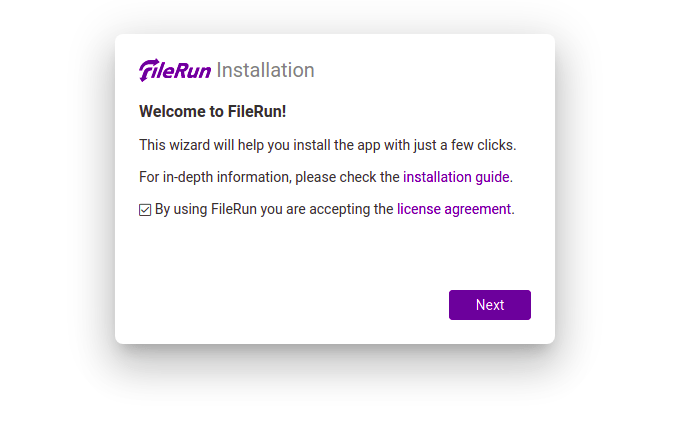How To Install FileRun on AlmaLinux 8

In this tutorial, we will show you how to install FileRun on AlmaLinux 8. For those of you who didn’t know, FileRun is a free, open-source, and self-hosted file share and sync application written in PHP. With a user-friendly web interface, you can store and manage files, photos, movies, and more
This article assumes you have at least basic knowledge of Linux, know how to use the shell, and most importantly, you host your site on your own VPS. The installation is quite simple and assumes you are running in the root account, if not you may need to add ‘sudo‘ to the commands to get root privileges. I will show you the step-by-step installation of the FileRun file management desktop sync and file sharing on an AlmaLinux 8. You can follow the same instructions for CentOS and Rocky Linux.
Prerequisites
- A server running one of the following operating systems: AlmaLinux 8, CentOS, and Rocky Linux 8.
- It’s recommended that you use a fresh OS install to prevent any potential issues.
- SSH access to the server (or just open Terminal if you’re on a desktop).
- A
non-root sudo useror access to theroot user. We recommend acting as anon-root sudo user, however, as you can harm your system if you’re not careful when acting as the root.
Install FileRun on AlmaLinux 8
Step 1. First, let’s start by ensuring your system is up-to-date.
sudo dnf clean all sudo dnf update
Step 2. Installing a LAMP server.
An AlmaLinux LAMP server is required. If you do not have LAMP installed, you can follow our guide here.
Step 3. Installing Ioncube PHP Loader.
Now we download the Ioncube Loader installer package from the official page:
wget https://downloads.ioncube.com/loader_downloads/ioncube_loaders_lin_x86-64.tar.gz
Next, extract the downloaded file:
tar xzf ioncube_loaders_lin_x86-64.tar.gz mv ioncube/ioncube_loader_lin_7.4.so /usr/lib64/php/modules/
After that, edit the PHP configuration file and define the Ioncube module path:
nano /etc/php.ini
Add the following configuration:
zend.assertions = -1 zend_extension = "/usr/lib64/php/modules/ioncube_loader_lin_7.4.so"
Save and close the file then, start Apache, MariaDB, and PHP-FPM services:
sudo systemctl start httpd sudo systemctl start mariadb ssudo ystemctl start php-fpm
Step 4. Installing FileRun on Rocky Linux 8.
By default, FileRun is not available on Rocky Linux 8 base repository. Now we run the commands below to download the latest version of FileRun from the official page:
wget -O FileRun.zip https://filerun.com/download-latest
Next, unzip the downloaded file using the following command:
unzip FileRun.zip -d /var/www/html/filerun/
We will need to change some folders permissions:
chown -R apache:apache /var/www/html/filerun
Step 5. Configuring MariaDB.
By default, MariaDB is not hardened. You can secure MariaDB using the mysql_secure_installation script. you should read and below each step carefully which will set a root password, remove anonymous users, disallow remote root login, and remove the test database and access to secure MariaDB:
mysql_secure_installation
Configure it like this:
- Set root password? [Y/n] y - Remove anonymous users? [Y/n] y - Disallow root login remotely? [Y/n] y - Remove test database and access to it? [Y/n] y - Reload privilege tables now? [Y/n] y
Next, we will need to log in to the MariaDB console and create a database for the FileRun. Run the following command:
mysql -u root -p
This will prompt you for a password, so enter your MariaDB root password and hit Enter. Once you are logged in to your database server you need to create a database for FileRun installation:
MariaDB [(none)]> CREATE DATABASE filerun; MariaDB [(none)]> GRANT ALL PRIVILEGES ON filerun.* TO 'filerun'@'localhost' IDENTIFIED BY 'your-strong-password'; MariaDB [(none)]> FLUSH PRIVILEGES; MariaDB [(none)]> EXIT;
Step 6. Configure Apache.
Now we create an Apache configuration file with the command:
nano /etc/httpd/conf.d/filerun.conf
Add the following file:
<VirtualHost *:80>
ServerName your-domain.com
DocumentRoot /var/www/html/filerun
<Directory "/var/www/html/filerun">
Options Indexes FollowSymLinks
AllowOverride All
Require all granted
</Directory>
ErrorLog /var/log/httpd/filerun.error.log
CustomLog /var/log/httpd/filerun.access.log combined
</VirtualHost>
Save and close the file, then restart the Apache service to apply the changes:
sudo systemctl restart httpd
Step 7. Secure Apache with Let’s Encrypt SSL Free Certificate
First, we install Certbot using the following command below:
sudo dnf install certbot python3-certbot-apache
Then, install the SSL certificate for Apache as below:
sudo certbot --apache
Proceed to an interactive prompt and install the certificate. If the certificate is installed you will see the below congratulatory message:
Deploying certificate Successfully deployed certificate for your-domain.com to /etc/httpd/conf.d/your-domain-le-ssl.conf Congratulations! You have successfully enabled HTTPS on https://your-domain.com NEXT STEPS: - The certificate will need to be renewed before it expires. Certbot can automatically renew the certificate in the background, but you may need to take steps to enable that functionality. See https://certbot.org/renewal-setup for instructions. - - - - - - - - - - - - - - - - - - - - - - - - - - - - - - - - - - - - - - - - If you like Certbot, please consider supporting our work by: * Donating to ISRG / Let's Encrypt: https://letsencrypt.org/donate * Donating to EFF: https://eff.org/donate-le - - - - - - - - - - - - - - - - - - - - - - - - - - - - - - - - - - - - - - - -
Step 8. Configure Firewall.
Allow the firewall to HTTP and HTTPS and reload it with the following commands:
sudo firewall-cmd --permanent --zone=public --add-service=http sudo firewall-cmd --permanent --zone=public --add-service=https sudo firewall-cmd --reload
Step 9. Accessing FileRun Web Interface.
Once successfully installed, open your web browser and access the FileRun using the URL https://your-domain.com. You will be redirected to the following page:

Congratulations! You have successfully installed FileRun. Thanks for using this tutorial for installing the FileRun PHP file manager dan file sharing on your AlmaLinux 8 system. For additional help or useful information, we recommend you check the official FileRun website.